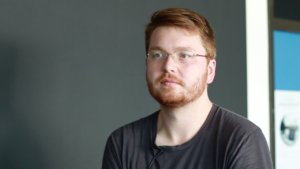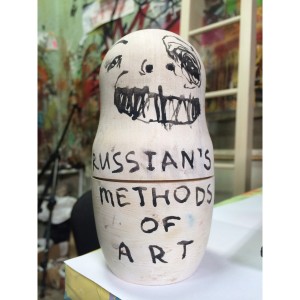Here at Schimmel, we showed the eighth iteration of this particular strand of performances. They base on the same text which is read, and it’s the center of the choreography in the somehow core of the whole piece. But somehow, they vary in the objects used and the site specificity of the installation. Also, it is always performed by different people, so it’s always the group dynamic that influences each iteration of the performance. From the beginning we used facebook a lot as a … like a group and sharing, like just a location of the reading. Because the reading group was quite nomadic at the beginning and we wanted everyone to be able to follow and to kind of … from distance or like to attend them on location. And also share the text between everyone, like to make it easily accessible or so. So, we would upload like PDFs and like so people could read it in distance. Yeah, and then we used Instagram a lot, but this is more like, when image making became like more significant for us, I guess. And the aesthetics of this reading group. (D.G.): A lot of our performances are shared online and when we do it, we kind of decide to do it, to share the documentation from the perspective of the performers. So somehow give the people who are inside the piece agency and how they want to represent themselves and which images they want to share, and when also. So, it’s not only the audience documenting from the outside but the performers documenting themselves and also the setting, the audience, the– yeah, the whole environment they’re in. And it is also another way of opening up the performance space and just sharing it further with the people that are not present in the space. I guess Agatha Valkyrie Ice is our earlier project. We started with this project kind of in parallel to Young Girl Reading Group. And this was a network of people that like agreed to contribute to creating a virtual character. For us I guess, it was like interesting to think about gender on the internet, like online basically and how it is like controlled and, if there is possibility of being this like genderless character online. Like multiple and genderless. We were reading a lot of about this post gender theory, like Shulamite Firestone and Thedger and I think this has inspired us to kind of experiment with that. So, there was a lot of people, involved throughout doing a variety of projects like exhibitions, like music, curated shows … we ran a project space in Basel in Switzerland under the name of Agatha Valkyrie Ice. So, somehow it was a very nice experiment, like to this kind of collective authorship in some way. (D.G.): And it somehow … the protect originated in text, in language also, so, it was somehow really important for us, to kind of … it was a bit of a role play for many people who just deciding to contribute to the project … they also decided to use and kind of propagate this language, this way of expression, which didn’t distinguish between the genders and it also didn’t distinguish between singular and plural, so, that was somehow kind of a statement within the art context that really blurred the boundaries between who is the artist, who is the curator, who have you kind of … I don’t know built something within cultural production without defining maybe yourself and others as such. So, it really kind of flattened in a way … the experience in the communication also, which was especially interesting when we were running a project space, to kind of stop distinguishing between yeah the space, the curators of the space, the artist that contribute and then the overall kind of outcome of that experiment. I guess for us it’s … we’re kind of interested in these forms that are open. So, with our work, especially the performative work, we kind of never really defined its like start point and endpoint. We kind of really want to have like room for growth with each project. That’s why we’re not very rigid with the scripting of the choreography, the way we use elements, sets, objects, that we make. (E.K.): Yeah, and I guess it’s like … we never consider it finished, because it can always change and it is like a nature of Young Girl Reading Group and Agatha also: everything can be rewritten, like, restaged or like modulated in some way. I guess, it’s a lot like research project, cause like we’re still continue doing reading so, like reading is a core, like we read a lot of theory and of course like your ideas change throughout, through learning, so like you don’t want to maybe like make a commitment to the ideas that you had a few years ago. And this theory changes ideas, every new, so somehow like we’re like the project to change with it. I guess, it is a little bit of an accumulative process there because they mimic each other in some way, so like they mimic people from the previous performances so, like these poses are suggestions of like what other people kind of like proposed to us. We also like look a lot at painting, also like, masters etc. So, more like … old material. (D.G.): Yeah, we looked a lot at representations of saints actually, from like this international gothic period which is like this … I don’t know, just for us like viral images of people in a way. So, just to kind of think about the image and the representation of the self and the attributes of a person and … so, it’s a lot of, a lot of the poses are taken from those paintings, I think. (E.K.): Yeah, but I guess, a lot like from social media also, like the main kind of thread that goes through this performance, is this awkward poses that like … poses that you like wouldn’t maybe take for reading and how it changes your voice and how it changes the reading and how much like text is related to the body also, like in perception of text is related to the body, this kind of connection. So, there is lot of sort from fashion in some ways, like also yes – (D.G.): Yes, the references are multiple.

















